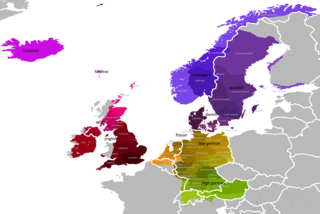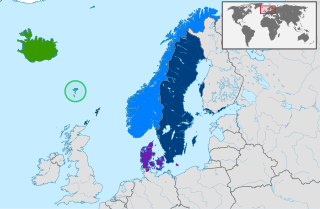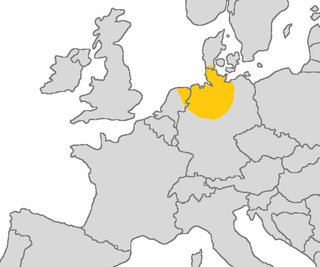
In phonology, an allophone is one of multiple possible spoken sounds – or phones – used to pronounce a single phoneme in a particular language. For example, in English, the voiceless plosive and the aspirated form are allophones for the phoneme, while these two are considered to be different phonemes in some languages such as Central Thai. Similarly, in Spanish, and are allophones for the phoneme, while these two are considered to be different phonemes in English.

The Germanic languages are a branch of the Indo-European language family spoken natively by a population of about 515 million people mainly in Europe, North America, Oceania and Southern Africa. The most widely spoken Germanic language, English, is also the world's most widely spoken language with an estimated 2 billion speakers. All Germanic languages are derived from Proto-Germanic, spoken in Iron Age Scandinavia and Germany.

Old Norse, Old Nordic, or Old Scandinavian is a stage of development of North Germanic dialects before their final divergence into separate Nordic languages. Old Norse was spoken by inhabitants of Scandinavia and their overseas settlements and chronologically coincides with the Viking Age, the Christianization of Scandinavia and the consolidation of Scandinavian kingdoms from about the 8th to the 15th centuries.

The North Germanic languages make up one of the three branches of the Germanic languages—a sub-family of the Indo-European languages—along with the West Germanic languages and the extinct East Germanic languages. The language group is also referred to as the Nordic languages, a direct translation of the most common term used among Danish, Faroese, Icelandic, Norwegian, and Swedish scholars and people.

Proto-Germanic is the reconstructed proto-language of the Germanic branch of the Indo-European languages.
The orthography of the Old Norse language was diverse, being written in both Runic and Latin alphabets, with many spelling conventions, variant letterforms, and unique letters and signs. In modern times, scholars established a standardized spelling for the language. When Old Norse names are used in texts in other languages, modifications to this spelling are often made. In particular, the names of Old Norse mythological figures often have several different spellings.
Middle Dutch is a collective name for a number of closely related West Germanic dialects whose ancestor was Old Dutch. It was spoken and written between 1150 and 1500. Until the advent of Modern Dutch after 1500 or c. 1550, there was no overarching standard language, but all dialects were mutually intelligible. During that period, a rich Medieval Dutch literature developed, which had not yet existed during Old Dutch. The various literary works of the time are often very readable for speakers of Modern Dutch since Dutch is a rather conservative language.

A rune is a letter in a set of related alphabets known as runic alphabets native to the Germanic peoples. Runes were used to write Germanic languages before they adopted the Latin alphabet, and for specialised purposes thereafter. In addition to representing a sound value, runes can be used to represent the concepts after which they are named (ideographs). Scholars refer to instances of the latter as Begriffsrunen. The Scandinavian variants are also known as fuþark, or futhark, these names derived from the first six letters of the script, ⟨ᚠ⟩, ⟨ᚢ⟩, ⟨ᚦ⟩, ⟨ᚨ⟩/⟨ᚬ⟩, ⟨ᚱ⟩, and ⟨ᚲ⟩/⟨ᚴ⟩, corresponding to the Latin letters ⟨f⟩, ⟨u⟩, ⟨þ⟩/⟨th⟩, ⟨a⟩, ⟨r⟩, and ⟨k⟩. The Anglo-Saxon variant is futhorc, or fuþorc, due to changes in Old English of the sounds represented by the fourth letter, ⟨ᚨ⟩/⟨ᚩ⟩.

Old Saxon, also known as Old Low German, was a Germanic language and the earliest recorded form of Low German. It is a West Germanic language, closely related to the Anglo-Frisian languages. It is documented from the 8th century until the 12th century, when it gradually evolved into Middle Low German. It was spoken throughout modern northwestern Germany, primarily in the coastal regions and in the eastern Netherlands by Saxons, a Germanic tribe that inhabited the region of Saxony. It partially shares Anglo-Frisian's Ingvaeonic nasal spirant law which sets it apart from Low Franconian and Irminonic languages, such as Dutch, Luxembourgish and German.
The Younger Futhark, also called Scandinavian runes, is a runic alphabet and a reduced form of the Elder Futhark, with only 16 characters, in use from about the 9th century, after a "transitional period" during the 7th and 8th centuries. The reduction, somewhat paradoxically, happened at the same time as phonetic changes that led to a greater number of different phonemes in the spoken language, when Proto-Norse evolved into Old Norse. Also, the writing custom avoided carving the same rune consecutively for the same sound, so the spoken distinction between long and short vowels was lost in writing. Thus, the language included distinct sounds and minimal pairs that were written the same.
Jera is the conventional name of the j-rune ᛃ of the Elder Futhark, from a reconstructed Common Germanic stem *jēra- meaning "harvest, (good) year".
Swedish has a large vowel inventory, with nine vowels distinguished in quality and to some degree in quantity, making 18 vowel phonemes in most dialects. Another notable feature is the pitch accent, a development which it shares with Norwegian. Swedish pronunciation of most consonants is similar to that of other Germanic languages.
A-mutation is a metaphonic process supposed to have taken place in late Proto-Germanic.
Old English phonology is necessarily somewhat speculative since Old English is preserved only as a written language. Nevertheless, there is a very large corpus of the language, and the orthography apparently indicates phonological alternations quite faithfully, so it is not difficult to draw certain conclusions about the nature of Old English phonology.
Like many other languages, English has wide variation in pronunciation, both historically and from dialect to dialect. In general, however, the regional dialects of English share a largely similar phonological system. Among other things, most dialects have vowel reduction in unstressed syllables and a complex set of phonological features that distinguish fortis and lenis consonants.

Gothic is an extinct East Germanic language that was spoken by the Goths. It is known primarily from the Codex Argenteus, a 6th-century copy of a 4th-century Bible translation, and is the only East Germanic language with a sizeable text corpus. All others, including Burgundian and Vandalic, are known, if at all, only from proper names that survived in historical accounts, and from loanwords in other, mainly Romance, languages.
Old Norse has three categories of verbs and two categories of nouns. Conjugation and declension are carried out by a mix of inflection and two nonconcatenative morphological processes: umlaut, a backness-based alteration to the root vowel; and ablaut, a replacement of the root vowel, in verbs.
Proto-Sámi is the hypothetical, reconstructed common ancestor of the Sámi languages. It is a descendant of the Proto-Uralic language.
The phonology of Old Saxon mirrors that of the other ancient Germanic languages, and also, to a lesser extent, that of modern West Germanic languages such as English, Dutch, Frisian, German, and Low German.
The phonological system of the Old English language underwent many changes during the period of its existence. These included a number of vowel shifts, and the palatalisation of velar consonants in many positions.









